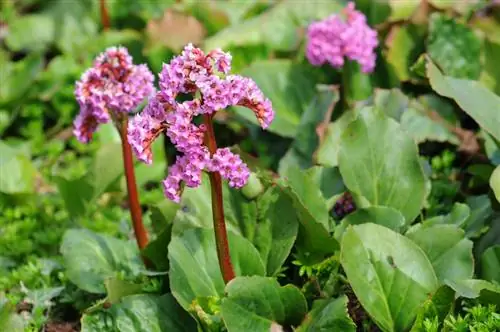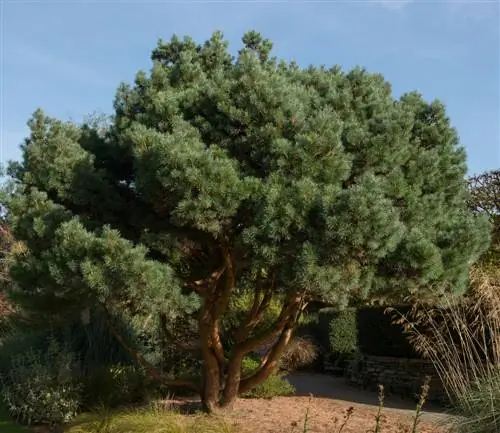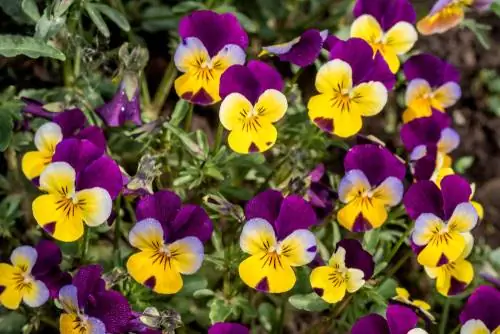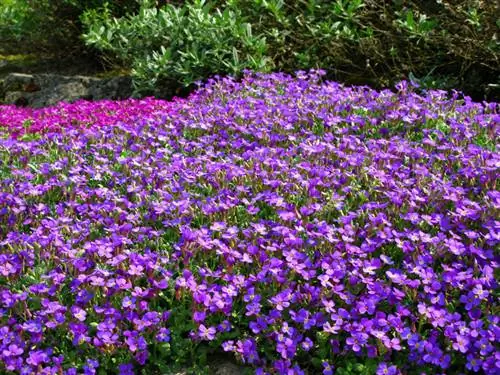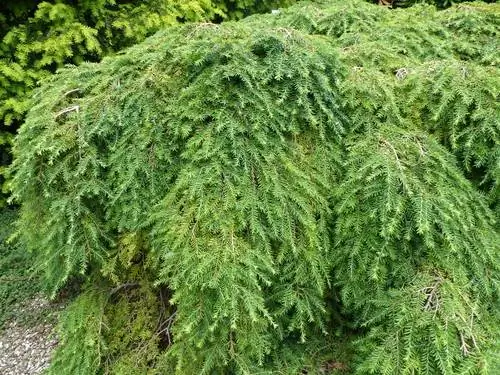- Author admin [email protected].
- Public 2023-12-25 17:45.
- Last modified 2025-01-23 11:22.
If the evergreen bergenia is integrated into the garden design, dreary corners in low-light to shady locations become a thing of the past. Instead, the perennial sets eye-catching accents with its enchanting spring blossoms. The rest of the year the mighty decorative leaves appear in wonderful, shiny metallic color nuances. How to properly cultivate the floral all-rounder will no longer be hidden from you here.
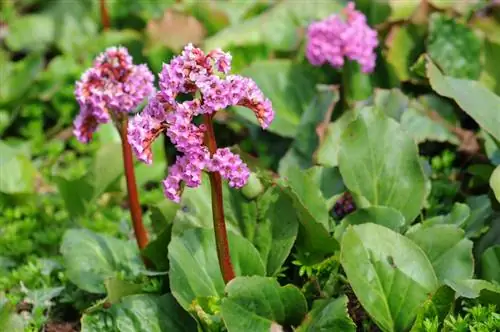
How do you properly care for a bergenia?
The Bergenia is a decorative perennial that grows in sunny to semi-shady locations. It blooms from April to May and has impressive decorative foliage. Ideal conditions are nutrient-rich, humus-rich soil and regular watering and fertilization from March to August.
Planting Bergenia correctly
When the leaves fall in autumn, the planting time for bergenias begins. Proper soil preparation is now important so that the decorative shrub roots quickly and blooms for the first time next spring. In a sunny, semi-shaded or shady location, loosen the soil finely and add leaf mold, compost, horn shavings and some expanded clay. The planting pit should be 1.5 times larger than the root ball. Before unpotting, this is placed in water until no more air bubbles appear. If you place the rootworm in the ground, the previous planting depth is maintained as much as possible. Last but not least, water generously and mulch with leaves or bark mulch.
Care tips
You will do a good job caring for Bergenia if you take the following measures to heart:
- Water the perennial repeatedly in summer droughts with rain (€144.00 on Amazon) and tap water alternately
- From March to August, fertilize monthly with compost, plant manure, guano granules or bark humus
- Fertilize pot bergenia liquid every 2 weeks
- Cut out wilted flower stems and unsightly leaves
- Pruning the foliage perennial close to the ground, preferably in late winter
- If there are late ground frosts, protect the flowers with garden fleece or foil
Winter protection is only advisable for bergenias in the planting year and in pots. The root disc is covered with autumn leaves or coniferous twigs. Planters are covered with weather-resistant fabric or bubble wrap.read more
Which location is suitable?
There is a persistent rumor that Bergenia may only be in the shade. The German queen of bergenia, Rosemarie Eskuche, repeatedly pointed out that wrapworts reach their optimum in sunny to partially shaded locations. The vitality of the flower and foliage plant only suffers under direct sunlight. While other perennials lose their beauty in places with little light, the bergenia retains its floral charisma.read more
The correct planting distance
Since a bergenia grows quite large over the years, we recommend a planting distance of 35-40 cm for common species and varieties. If the ornamental perennial acts as a ground cover, plant 6-8 plants per square meter. An exception are the dwarf varieties, which are arranged at a distance of 25-30 cm from each other.
What soil does the plant need?
Bergenia finds ideal conditions in nutrient-rich, humus-rich soil. It likes to extend its roots in fresh, moist to moderately dry soil. Wherever there is neither waterlogging nor desert-like dryness, the decorative foliage plant remains loyal to you. This applies to the rock garden and the perennial bed as well as to the edge of your private water world.
When is flowering time?
From April to May, the colorful flowers are enthroned on fleshy stems above the basal rosettes of leaves. Newer cultivars have the potential for autumnal rebloom. Therefore, cut off the withered flower stalks to make room for new growth. A well-measured portion of compost after this cut gives additional energy to the subsequent flowering.
Cut bergenia correctly
Lovingly cared for, the bergenia takes on enormous dimensions. To maintain a well-groomed appearance and to keep the circumference under control when necessary, repeated trimming is essential. How to do it right:
- Cut off wilted flower stems before the vigorous seed growth begins
- Cut out or pluck out individual yellowed or withered leaves from the clump
- In January/February, cut off the entire perennial close to the ground
The strong flower stems and shapely decorative leaves are also wonderful for long-lasting vase decorations.read more
Watering Bergenia
The fleshy flower stalks and juicy heart leaves belie the fact that the bergenia is surprisingly tolerant of short-term drought, as long as this condition remains the exception. Ideally, you should always water the perennial when the thumb test indicates dried soil. Switching between soft rainwater and normal tap water meets the requirements in an exemplary manner.
Fertilize Bergenia properly
To fertilize the bergenia organically, add compost, horn shavings, guano, bark humus or nettle manure to the root disc every 4 weeks from March to August. Cultivated in a bucket, the nutrient requirement increases because the supplies are used up more quickly. In this case, apply a liquid fertilizer every 14 days during the specified period. Alternatively, press long-acting fertilizer sticks into the substrate according to the manufacturer's instructions.
Wintering
An adult bergenia calmly accepts normal winter weather with temperatures down to -28.4 degrees Celsius. It becomes problematic for the ornamental perennial if there is no snow in the bitter cold. In addition, early flowering is always threatened by delayed ground frosts. The following measures must therefore be observed:
- In the year of planting, cover the root ball with autumn leaves and conifers
- If there is a threat of ground frost during flowering, put a fleece or foil over it
- If there is a clear frost, water the plants on mild days
Every winter, planters are covered with jute ribbons, bubble wrap or fleece. If the pot is not already on a plant roller, slide a block of wood under it.
Propagate Bergenia
Many hobby gardeners' passion for collecting awakens once the numerous advantages of Bergenia are known. Good to know that there are no hurdles to overcome for breeding. The following methods have proven to be very effective:
- Division of the rhizome ball in autumn or spring
- Separate the runners so that they can be rooted in the pot as 5 cm long root cuttings
- Sowing seeds on the windowsill
While direct sowing will most likely give you a headache, sowing behind glass is uncomplicated. Sprinkled on seed soil or peat sand, germination progresses quickly at 20-23 degrees Celsius and uniform moisture.read more
Is bergenia poisonous?
If there are children and pets in your garden, bergenia is the ideal plant. Since the majestic ornamental perennial has no toxic ingredients, it can be cultivated in the family garden with a clear conscience.read more
Beautiful varieties
- Oeschberg: Premium variety with dark red, shiny decorative leaves under pink flowers and the potential for rebloom
- Bressingham White: Features white and pink flowers, red-green heart leaves and bronze autumn leaves
- Baby Doll: Magnificent dwarf variety that sets picturesque accents in small gardens all year round; Growth height 25-30 cm
- Admiral: Magnificent bergenia with pink flowers on dark red stems and upright leaves that turn red in winter
- Evening bells: Elegant hybrid with extraordinary, dark red bell flowers over fresh green heart leaves

